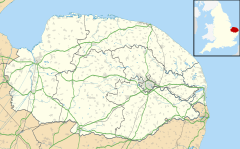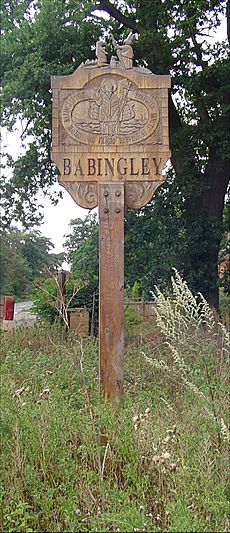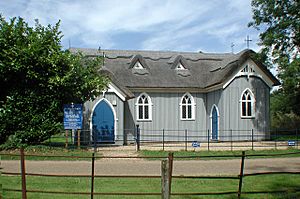Babingley facts for kids
Quick facts for kids Babingley |
|
|---|---|
 Ruin of St Felix's parish church |
|
| OS grid reference | TF675264 |
| Civil parish | |
| District | |
| Shire county | |
| Region | |
| Country | England |
| Sovereign state | United Kingdom |
| Post town | King's Lynn |
| Postcode district | PE30 |
| Dialling code | 01485 |
| Police | Norfolk |
| Fire | Norfolk |
| Ambulance | East of England |
| EU Parliament | East of England |
| UK Parliament |
|
Babingley is a small village in Norfolk, England. It is located about 1 mile (1.6 km) northwest of Castle Rising. It is also about 5 and a half miles (8.9 km) north-northeast of King's Lynn. Babingley used to be a separate area called a civil parish. But in 1935, it became part of the nearby Sandringham area. In 1931, only 91 people lived there.
The name 'Babingley' is very old. It was first written down in the Domesday Book in 1086. The Domesday Book was a huge survey of England ordered by William the Conqueror. The name 'Babingley' means 'the clearing of Babba's people'.
Today, Babingley is a small group of houses. They are found along the A149 road which connects King's Lynn and Hunstanton. The original, older village site is in fields west of this main road. You can still see the ruin of St Felix's old church there.
Contents
Saint Felix and the Beaver Legend
Babingley is famous because it's believed to be where Saint Felix first arrived in Britain. This was around the year AD 615. Saint Felix is known as the 'Apostle to the East Angles'. This means he was very important in bringing Christianity to the people of East Anglia.
The royal family of East Anglia, called the Wuffingas, invited Felix to teach their kingdom about Christianity. Babingley is quite far from their old capital city, Rendlesham. But it is said that Felix arrived here by the River Babingley. His ship supposedly found shelter from a big storm.
After landing, Felix traveled to Canterbury. There, Honorius, who was the Archbishop of Canterbury, made him a bishop. This happened around 630 AD, after King Sigebert of East Anglia asked for it. Saint Felix then set up his main church, called a cathedral, in a place called Dommoc. This might be the modern-day Walton.
There's a fun local story about Felix. It says that his ship crashed on the River Babingley. But a group of beavers saved him from drowning! To show his thanks, Felix supposedly made the leader of the beavers a bishop. The village sign in Babingley shows this legend. It has a picture of a beaver wearing a bishop's hat, looking after other beavers.
Babingley's Churches
Babingley has had two churches that belong to the Church of England. One is a very old church from the 1300s. The other is a newer church built in the 1800s.
The Ruined Old Church of St Felix
The old church of St Felix was built in the 1300s. People used it for worship until the 1800s. Now, it is a ruin. You can find it in a field near the River Babingley. It is part of the nearby Sandringham estate. Some people say this was the first Christian church ever built in Norfolk!
The parts of the church that are still standing were mostly built in a style called 'Decorated Gothic'. This was popular in the 1300s. The south porch, which is like a covered entrance, was added in the 1400s and is made of brick. Records show that parts of the church were already falling apart by the 1600s and 1700s. The last priest for this church was appointed in 1732.
A photo from 1949 shows that the church still had some of its roof then. But now, it has no roof at all. The church used to have a main hall (nave), side sections (aisles), a special area for the altar (chancel), and a tall tower at the west end. Over time, one of the side sections was taken down.
The famous artist John Piper painted this church ruin in the early 1980s. Since then, a lot of ivy has grown over the ruin, covering the tower too. This old church is a very important historical building. It is protected as a 'Grade I listed building' and a 'scheduled monument'.
The church ruin is on private land. You can only visit it if you get permission from the landowner.
The "Tin Tabernacle" Mission Church
In 1880, a new church was built by the main road. It was called the mission church of SS Mary and Felix. This church is quite unusual! It has a wooden frame covered with corrugated iron. These types of churches are sometimes called "tin tabernacles". What makes this one extra special is that it has a thatched roof, which is rare for a tin church.
After this new church was ready, the old 14th-century church was no longer used.
Butler's Cross
Butler's Cross is the bottom part and a broken piece of a very old stone cross. It's from the Middle Ages. You can find it on a small island in the road where the minor road to West Newton meets the main A149 road. Its name comes from the de Boteler family. They owned land in Babingley from the mid-1200s.




